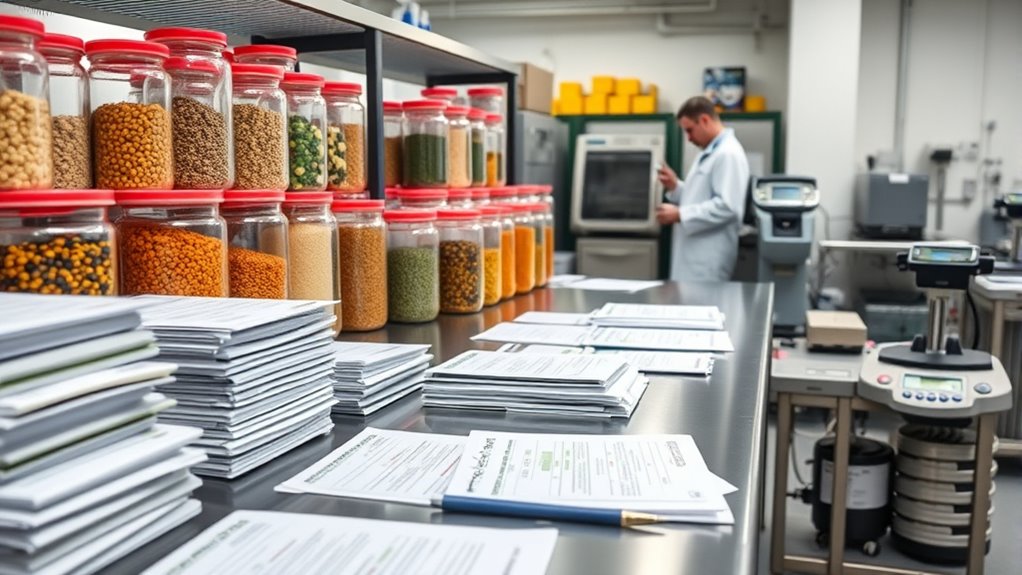To keep your organic facility certified, you need to maintain thorough documentation, including purchase logs, application records, and pest management logs. You’ll undergo unannounced inspections where their focus is on verifying storage, cleanliness, and that no prohibited substances are used. Proper record-keeping and preparation of internal audits make inspections smoother and help avoid compliance issues. Continue exploring to discover key tips for managing paperwork and processes efficiently to sustain your certification.
Key Takeaways
- Maintaining accurate, accessible records of sourcing, handling, and pest management is essential for organic certification compliance.
- Inspection procedures include verifying storage labeling, cleanliness, and absence of prohibited substances through physical and documentation review.
- Preparing for unannounced inspections by conducting internal audits streamlines the process and demonstrates transparency.
- Certification costs vary based on operation size and scope, encompassing application, renewal, and inspection fees.
- Thorough facility preparation and record-keeping help ensure smooth inspections and ongoing regulatory adherence.

Certified organic facilities play a essential role in guaranteeing that organic products meet strict standards for quality and sustainability. As someone involved in the process, you know that achieving certification isn’t just about meeting a checklist; it’s about committing to a system that guarantees integrity from farm to shelf. One of the first hurdles you’ll encounter is understanding organic certification costs. These costs can vary depending on the size of your operation, the scope of your production, and the certifying agency you choose. They typically include application fees, annual certification renewal, and inspection expenses. While they might seem steep initially, they’re an investment in building trust with consumers and accessing premium markets. Budgeting for these expenses upfront can help you plan effectively and avoid surprises down the line.
The certification process involves thorough facility inspection procedures designed to verify that your operation complies with organic standards. You’ll need to prepare your facility meticulously, ensuring all records are accurate and accessible. During inspection, a certifier will examine everything from storage areas and processing equipment to cleaning protocols and record-keeping practices. The goal is to confirm that no prohibited substances or practices have been used and that your operation maintains the integrity of organic standards. Expect questions about your sourcing, pest management, and handling procedures. Being transparent and cooperative during inspections can facilitate smoother approval and reduce the likelihood of non-compliance issues.
Understanding the facility inspection procedures is essential because they are the backbone of certification integrity. These inspections are unannounced in many cases, so you should always keep your documentation current and your facility in compliance. The inspector will review your records, such as purchase logs, application histories, and pest management logs, to ensure traceability and adherence to organic regulations. They’ll also inspect physical aspects of your operation—checking that storage containers are properly labeled, that prohibited substances aren’t present, and that your cleaning protocols prevent contamination. Preparing ahead by conducting internal audits can make the actual inspection less stressful and more efficient. Additionally, utilizing high-quality projectors can help you review your procedures and documentation clearly during internal audits or staff training sessions, ensuring everyone understands compliance requirements.
Frequently Asked Questions
How Long Does the Certification Process Typically Take?
The certification process usually takes about 3 to 6 months, depending on your ability to meet organic standards. You’ll need to submit paperwork, undergo inspections, and address any issues that arise. The certification timeline varies based on how quickly you provide required documentation and resolve questions. Staying organized and responsive helps speed up the process, so you can achieve organic certification and meet market demands sooner.
What Are Common Reasons for Certification Denial?
Getting denied certification is like hitting a roadblock on your journey—common reasons include failing organic compliance or missing documentation. You might overlook specific certification challenges, such as improper record-keeping or non-compliance with organic standards. These issues often stem from unclear processes or inadequate preparation. To avoid denial, guarantee your operations meet all organic criteria and that paperwork is thorough and accurate. Staying proactive helps clear the way to certification success.
Are There Specific Record-Keeping Requirements for Organic Facilities?
Yes, organic facilities must follow strict record keeping regulations. You need to maintain detailed documentation procedures, including records of inputs, treatments, and handling processes. This helps verify compliance with organic standards during audits. Accurate records ensure transparency and accountability, so you should regularly update and organize your documentation to meet certification requirements. Proper record keeping not only supports your certification but also demonstrates your commitment to maintaining organic integrity.
How Often Must Facilities Undergo Audits?
Audits happen more often than you’d imagine—usually once a year, which is the typical audit frequency for certified organic facilities. You’ll need to meet inspection requirements annually to stay compliant. This guarantees your operation maintains transparency and adheres to organic standards. Staying ahead with scheduled inspections helps you avoid surprises and keeps your certification intact, so plan for these audits as a crucial part of your ongoing organic journey.
What Costs Are Associated With Becoming Certified Organic?
The costs associated with becoming certified organic include certification expenses, which cover application fees, inspection costs, and annual renewal fees. You’ll also face cost implications for adjusting your operations to meet organic standards, like sourcing organic ingredients or upgrading equipment. These expenses vary depending on your facility size and scope. While initial costs can be significant, maintaining certification guarantees market credibility and access to organic markets, making it a worthwhile investment.
Conclusion
Managing the paperwork and processes for certified organic facilities might seem daunting, but it’s essential for authenticity and consumer trust. Did you know that over 25,000 facilities worldwide are certified organic, reflecting a 15% annual growth? This shows a growing demand for organic products and the importance of maintaining high standards. By staying organized and compliant, you contribute to a transparent, sustainable industry that consumers increasingly rely on for quality and integrity.









